
The Northern Circars was a division of British India's Madras Presidency. It consisted of a narrow slip of territory lying along the western side of the Bay of Bengal from 15° 40′ to 20° 17′ north latitude, in the present-day Indian states of Andhra Pradesh and Odisha. The Subah of Deccan (Hyderabad/Golconda) consisted of 22 circars. These northern circars were five in number and the most prominent ones in the Subah.

Jeypore is one of the largest towns and a place of historical significance in Koraput district in the Indian state of Odisha. It was established by Vir Vikram Dev in the mid 17th century. The kingdom was defeated by the East India Company in 1777 who declared it a Zamindari or Feudatory of the British Crown and much later got acknowledged as a Princely state until its dissolution in the Dominion of India in 1947.

Koraput district is a district of India in southern Odisha, with headquarters at Koraput. The district is located in the Eastern Ghats and is known for its hilly terrain, rich and diverse types of mineral deposits and its tribal culture and traditions. The district headquarters town of Koraput and its largest city, Jeypore are major centres of trade and commerce for South Odisha and fall on an important road connecting Visakhapatnam to Raipur.
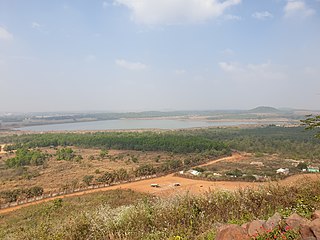
Nabarangpur district, also known as Nabarangapur district or Nawarangpur district, is a district of Odisha, India. The city of Nabarangpur is the district capital. Most of its population is tribal and the land is heavily forested. It borders Kalahandi and Koraput districts. Nabarangpur district is situated at 19.14′ latitude and 82.32′ longitude at an average elevation of 572 metres (1,877 ft).
The Jalaput Dam is a hydroelectric dam built on the Machkund River, a tributary of the Godavari River in India which rises in the Mudugal hills of Alluri Sitharama Raju district District and nearby Ondra Gadda it becomes the boundary between Andhra Pradesh and Odisha. This Dam is the most ignored one in India, currently, it is in dilapidated condition. For over 48 km the river runs nearly north along a meandering course through the Padwa Valley. About 48 km south of Jeypore, it winds westward along the edge of the Plateau and then suddenly tums at a short angle to the south-west down a steep descent popularly known as Duduma Falls.

Visakhapatnam district is one of the six districts in the Uttarandhra region of the Indian state of Andhra Pradesh, headquartered at Visakhapatnam. It is one of the twenty-six districts in Andhra Pradesh state. The district shares borders within the north and east, Vizianagaram district and South Anakapalli district in the south-west and Bay of Bengal in the south.

Koraput is a town and a Municipality in Koraput district in the Indian state of Odisha. Koraput town is the district headquarter of Koraput district.

The River Nagavali also known as Langulya is one of the main rivers of Southern Odisha and Andhra States in India, between Rushikulya and Godavari basins.
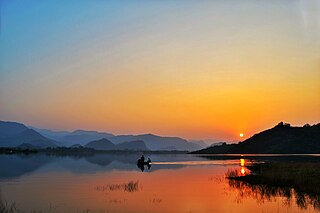
Pachipenta is a village in Vizianagaram district of the Indian state of Andhra Pradesh. It is located in Pachipenta mandal.

Madugula is a village in Anakapalli district in the state of Andhra Pradesh in India. It was also known as Vaddadi or Vaddadimadugula and was founded by the rulers of the Matsya dynasty. Later, it merged into the kingdom of Nandapur - Jeypore and during the British Raj it remained an independent Zamindari for sometime. Later, in 1915 the zamindaris of Madugula and Pachipenta were purchased by Maharaja Vikram Dev III and they became a part of Jeypore Samasthanam and were governed by the Maharaja of Jeypore until 1947.

North Andhra or Uttara Andhra, also known as Kalinga Andhra, is a geographic region in the Indian state of Andhra Pradesh. It is between the Eastern Ghats and the coast of the Bay of Bengal. It comprises six northern districts of the state, Srikakulam, Parvathipuram Manyam, Vizianagaram, Visakhapatnam, Alluri Sitharama Raju and Anakapalli. As of 2011 census of India, the region with six districts has a population of 9,338,177.

Vizagapatam District was a district in the Madras Presidency of British India. Covering an area of 44,600 square kilometres (17,222 sq mi) and sub-divided into 22 taluks.
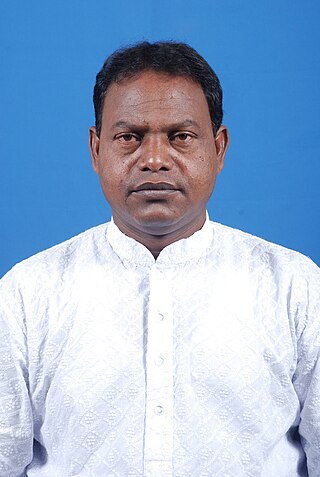
Pottangi is a Vidhan Sabha constituency of Koraput district, Odisha, India.
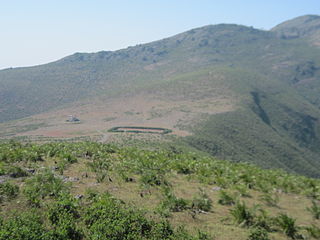
Deomali, is a mountain peak in the Chandragiri-Pottangi subrange of the Eastern Ghats. It is located near Koraput town in the Koraput district of Odisha, India.
Salur mandal is one of the 34 mandals in Parvathipuram Manyam district of the Indian state of Andhra Pradesh. It is administration under Parvathipuram revenue division and headquartered at Salur. The mandal is bounded by Makkuva, Ramabhadrapuram, Pachipenta and Bobbili mandals. A portion of it also borders the state of Odisha.
Makkuva mandal is one of the 34 mandals in Parvathipuram Manyam district of the Indian state of Andhra Pradesh. It is administration under Parvathipuram revenue division and headquartered at Makkuva. The mandal is bounded by Salur mandal on South & West, Parvathipuram mandal on North, Seethanagaram mandal on east and Bobbili mandal on south east. A portion of it also borders the Narayanapatna block of the Koraput district of Odisha on north west.
The Vizagapatam Hill Tracts Agency was an agency in the Madras Presidency of British India. The agency was autonomous and supervised by an agent subordinate to the District Collector of Vizagapatam District.
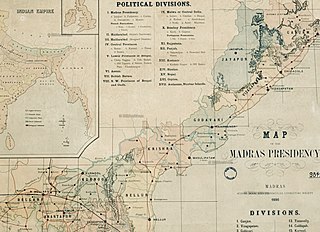
Jeypore Estate or Jeypore Zamindari was a Zamindari estate of the Madras Presidency and later of Orissa Province in British India. Historically it was a kingdom known as Jeypore Kingdom, located in the highlands of the western interiors of the Kalinga region that existed from the mid-15th century to 1777 CE. It was earlier a tributary state of the Gajapati Empire and following its decline in 1540, it gained sovereignty and later became a tributary state of the Qutb Shahis until 1671. The kingdom regained degrees of semi-independence until it became a vassal state of the British in 1777. It eventually formed a part of the linguistic Orissa Province in 1936 upon transfer from the Madras Province and became a part of the independent Union of India in 1947.
Desia, also Desiya or Desia Odia or Koraputi Odia or Southwestern Odia, is an Indo-Aryan language variety spoken in Koraput, Nabarangpur, Rayagada, Malkangiri districts Odisha and in the hilly regions of Vishakhapatnam and Vizianagaram districts of Andhra Pradesh. The variant spoken in Koraput is called Koraputia.

Parvathipuram Manyam district is a district in the Indian state of Andhra Pradesh. With Parvathipuram as its administrative headquarters, it became functional from 4 April 2022. The district was formed from Parvathipuram revenue division from Vizianagaram district and part of Palakonda revenue division of Srikakulam district. The district was once part of ancient Kalinga. The famous Kamalingeswara swamy temple was built in the regin of King Rajaraja Deva of Eastern Ganga Dynasty in 11th century CE.













